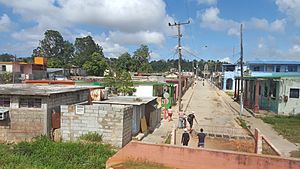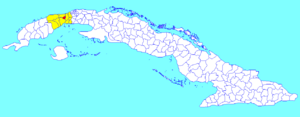Guanajay facts for kids
Quick facts for kids
Guanajay
|
|
|---|---|
 |
|

Guanajay municipality (red) within
Artemisa Province (yellow) and Cuba |
|
| Country | Cuba |
| Province | Artemisa |
| Founded | 1781 |
| Area | |
| • Total | 113 km2 (44 sq mi) |
| Elevation | 110 m (360 ft) |
| Population
(2022)
|
|
| • Total | 28,031 |
| • Density | 248.1/km2 (642.5/sq mi) |
| Time zone | UTC-5 (EST) |
| Area code(s) | +53-7 |
| Climate | Am |
Guanajay is a town and a special area (called a municipality) in western Cuba. It is located in the Artemisa Province, about 58 kilometers (36 miles) southwest of Havana. The town is built among hills.
Guanajay is also a 'twin town' with Axtla De Terrazas, a place in Mexico. This means they have a special friendly connection.
Contents
History of Guanajay
Guanajay was founded in 1650. It has a long and interesting history.
Early Days and Spanish Rule
During the time when Spain ruled Cuba (called colonial times), Guanajay was an important stop. It was a place where new soldiers arriving from Spain could get used to the climate. This was known as an "acclimatization station."
Later, Guanajay became famous as a "health resort." People would visit to relax and improve their health.
Changes in Provinces
For many years, Guanajay was part of the Pinar del Río Province. This lasted until 1976. After that, it became part of the La Habana Province. In 2011, the La Habana Province was split into two new provinces. Guanajay then became part of the new Artemisa Province.
Local Economy and Importance
The land around Guanajay is very fertile. This means it's great for growing crops. Farmers here grow important crops like sugarcane and tobacco.
Historically, Guanajay was a key place for trade. It helped distribute goods across the western part of Cuba. Even by the late 1700s, Guanajay was already a large and important town, known as an ancient pueblo.
Population of Guanajay
In 2022, the municipality of Guanajay had a population of 28,031 people. The total area of Guanajay is 113 square kilometers (about 44 square miles). This means there are about 250 people living in each square kilometer.
Images for kids
See also
 In Spanish: Guanajay para niños
In Spanish: Guanajay para niños



